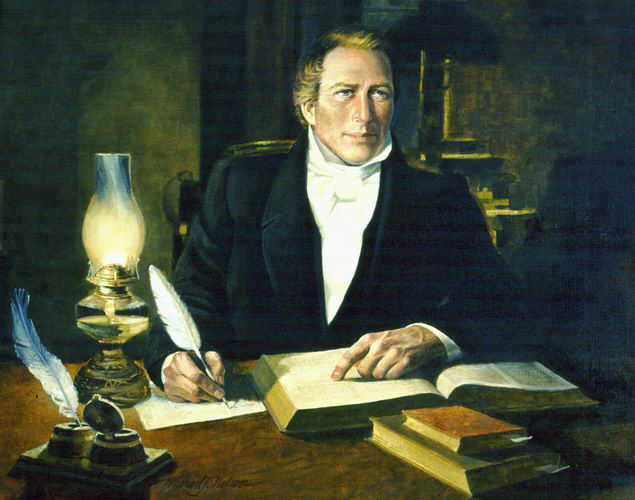Question
Dear Gramps,
I found peace coming to this site. There are a lot of good things about the gospel. I’m hungry for the word of God, but I still have a lot of questions. One of them goes like this:
How could Joseph Smith have seen God and Jesus at the same time accept Exodus 33:20?
Finding answers for my doubts, my faith will grow every day. I’m sure there is an answer for all questions, but because of our fragile faith we cannot find it.
I leave my all peace with you. God bless you.
Paul
Answer
Dear Paul,
Your confusion about Exodus 33:20 is quite understandable. In verse 20, the Lord, talking to Moses, tells him that he cannot see the Lord’s face for no man shall see Him and live. However, in verse 11 of the same chapter, we read And the Lord spake unto Moses face to face, as a man speaketh unto his friend. There is a very specific contradiction between these two verses in the same chapter.
Of course, the word of God could never contain any contradictions, so we must examine what is written in the bible. The King James Bible in the English Language is the twelfth in line of previous different translations and versions. Briefly, they are as follows.
Of course the original manuscripts have all been lost. The three most ancient copies of those manuscripts are:
a) the Codex Sinaiticus, written in the 4th century, now in the British Museum.
b) the Codex Alexandrinus, probably written in the 5th century, also in the British Museum
c) the Codex Vaticanus, also written in the 4th century and deposited in the Vatican library at Rome.
Based on those renditions, we have what are called the ancient copies. These are:
a) The Septuagint Version, copied from the 285 B.C. Greek translation of the Old Testament.
b) The Samarian Pentateuch. This version of the first five books of the bible was written in Samarian characters.
c) Peshito or Seriac, written in the common language of certain parts of Syria.
d) The Vulgate. This version was translated into Latin by Jerome at Bethlehem, and was the standard bible of the Catholic Church for a thousand years.
The English language versions that followed were:
The Wycliffe Bible. John Wycliffe lived from 1320 to 1384.The Tyndale Bible. William Tyndale’s translation of the Pentateuch was issued in 1530.
The Coverdale Bible. Largely based on Tyndale’s bible, was published in 1535.
The Mathews Bible. Published in 1537, was based on both Tyndale’s and Coverdale’s work.
The Great Bible. 1539, based on the Matthews, Coverdale and Tyndale bibles.
The Geneva Bible. 1560, a scholarly revision of the Great Bible.
The Bishop’s Bible. 1568, from the Great Bible and the Geneva Bible.
The Douay Bible. New Testament in 1582, the Old Testament in 1609-1610. This was an English translation of the Latin Vulgate.
The King James Bible. 1881-1884, based principally on the Geneva bible, but with reference to the Hebrew and Greek texts.
Little wonder that we find numerous inconsistences, such as the one that you refer to, in the scriptures of the day. Joseph Smith, a prophet much like Moses, was called by God to reestablish His church and kingdom on the earth. Joseph did this in fulfillment of the prophecies of both the Old and New Testaments, and the Church of Jesus Christ of Latter-day Saints (Mormon Church) was organized on April 6, 1830.
At that time the Lord gave to the prophet Joseph a new scripture, not previously known, that was written in the Egyptian language, which recorded God’s dealings with man on the Western Hemisphere during the period from 600 AD to 400 BC. That scripture was translated into English by Joseph Smith, as he recorded, “by the gift and power of God.” It is known as the Book of Mormon. After the Mormon Church was organized, the Lord instructed Joseph to make a new translation of the Bible, by correcting the King James version.
Let us now go to the Joseph Smith translation of the King James version of Exodus 33:20.
And he said unto Moses, Thou canst not see my face at this time, lest mine anger be kindled against thee also, and I destroy thee, and thy people; for there shall no man among them see me at this time, and live, for they are exceeding sinful. And no sinful man hath at any time, neither shall there be any sinful man at any time, that shall see my face and live.
This verse clarifies the discrepancy found in the King James version between verses 11 and 20 of Exodus 33. The phrase in King James, for no man shall see me and live, is the remains of the original text as given by God to Joseph Smith, and so much of the original has been lost that the meaning has been completely altered. Seeing that verse as it originally was makes clear and understandable the context of the chapter, and restores confidence in the truthfulness of the Bible as it was originally written. One of the Articles of Faith of the Mormon Church is, We believe the Book of Mormon to be the word of God. We also believe the Bible to be the word of God as far as it is translated correctly.
Gramps







